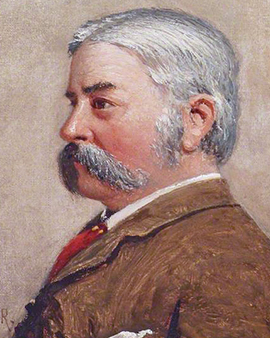


Benjamin Williams Leader is one of the most famous British landscape painters of the 19th and 20th centuries. Born on 12 March 1831 in Worcester, he spent many years of his life in Worcestershire, Wales, Surrey and Scotland. These landscapes were his main motifs. By then standards, he became quite old at 92.
This is due to the fact that his father was quite wealthy as the owner of an engineering office and that he was already selling successfully during his studies. After graduating from the Royal Grammar School Worcester he therefore worked as a draughtsman for his father. His hobby was painting. Therefore he made many trips to the river Severn. In the evening he graduated from the Worcester School of Design. It is well documented that Leader attended the Royal Academy of Arts in London in 1854, where he constantly took courses in landscape painting during his free time. After one year he was allowed by the Academy to exhibit his painting "Cottage Children blowing bubbles". An American art lover even paid the considerable sum of £50 for it at that time. After that he always exhibited at the Academy's exhibitions. He never graduated from the Academy, but always sold paintings. So he sold directly to private art collectors through the art trade. These paintings were never exhibited. In 1898 he became a full member of the Royal Academy of Arts.
Due to his considerable success already during his lifetime, his most famous works "In the Evening there shall be light" and "February Fill Dyke" achieved sensational prices. Benjamin Williams Leader painted mainly in oil. These were landscape paintings with a lot of perspective and details partly on canvas, partly on cardboard, colour lithographs or engravings. His most famous engraving is that of "Tintern Abbey by Moonlight". Some of them bear witness to a stay in Switzerland. His favourite motifs are river landscapes.
Leader captured the landscapes of his homeland with his works. He brought them closer to those who had come to know and love them as visitors, and created memories for those whose home it was. His paintings are expressive, some of them colorful, but he was not at all interested in portraiture. People and animals are only sparsely represented in his works and when they are, they show almost no details. Due to his good financial basis he could fully dedicate himself to his painting. Compared to other painters of his time, such as Lynch or Stokes, he almost never travelled abroad, but spent most of his time in Great Britain. The fact that he had sold many works before anyone but himself and his art dealers had seen them makes it always likely to find a still unknown "leader". Those paintings that are known are offered at very good prices in the most famous auction houses of the world.

Benjamin Williams Leader is one of the most famous British landscape painters of the 19th and 20th centuries. Born on 12 March 1831 in Worcester, he spent many years of his life in Worcestershire, Wales, Surrey and Scotland. These landscapes were his main motifs. By then standards, he became quite old at 92.
This is due to the fact that his father was quite wealthy as the owner of an engineering office and that he was already selling successfully during his studies. After graduating from the Royal Grammar School Worcester he therefore worked as a draughtsman for his father. His hobby was painting. Therefore he made many trips to the river Severn. In the evening he graduated from the Worcester School of Design. It is well documented that Leader attended the Royal Academy of Arts in London in 1854, where he constantly took courses in landscape painting during his free time. After one year he was allowed by the Academy to exhibit his painting "Cottage Children blowing bubbles". An American art lover even paid the considerable sum of £50 for it at that time. After that he always exhibited at the Academy's exhibitions. He never graduated from the Academy, but always sold paintings. So he sold directly to private art collectors through the art trade. These paintings were never exhibited. In 1898 he became a full member of the Royal Academy of Arts.
Due to his considerable success already during his lifetime, his most famous works "In the Evening there shall be light" and "February Fill Dyke" achieved sensational prices. Benjamin Williams Leader painted mainly in oil. These were landscape paintings with a lot of perspective and details partly on canvas, partly on cardboard, colour lithographs or engravings. His most famous engraving is that of "Tintern Abbey by Moonlight". Some of them bear witness to a stay in Switzerland. His favourite motifs are river landscapes.
Leader captured the landscapes of his homeland with his works. He brought them closer to those who had come to know and love them as visitors, and created memories for those whose home it was. His paintings are expressive, some of them colorful, but he was not at all interested in portraiture. People and animals are only sparsely represented in his works and when they are, they show almost no details. Due to his good financial basis he could fully dedicate himself to his painting. Compared to other painters of his time, such as Lynch or Stokes, he almost never travelled abroad, but spent most of his time in Great Britain. The fact that he had sold many works before anyone but himself and his art dealers had seen them makes it always likely to find a still unknown "leader". Those paintings that are known are offered at very good prices in the most famous auction houses of the world.
Page 1 / 1








